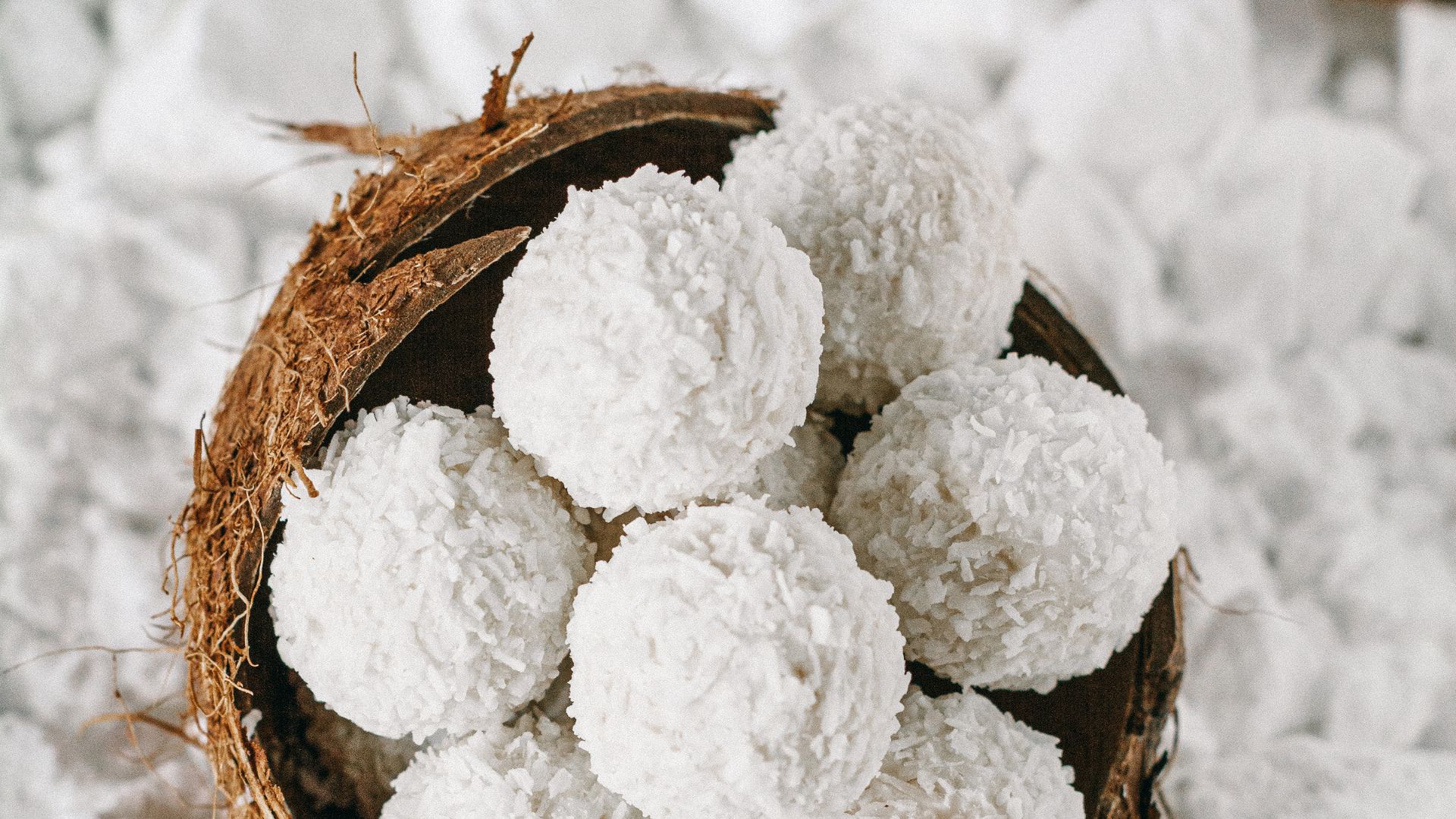In this topic, I’m going to talk about DC – Dry Coconut – and its role in cookie making, drawing from my own personal experience. Dry coconut is an ingredient that brings a lot to the table, enhancing cookies with a unique texture and flavor. I’ll delve into what dry coconut is, how it fits into the cookie-baking process, and why you might want to consider using it in your next batch.
Table of Contents
ToggleWhat is Dry Coconut (DC)?
Dry coconut, often referred to as shredded or desiccated coconut, is the meat of the coconut that has been dried to remove most of its moisture. Unlike fresh coconut, which is juicy and sweet, dry coconut has a firm texture and a more concentrated coconut flavor. It comes in various forms – shredded, flaked, or finely ground – and can be used in both sweet and savory dishes.== >> Check out the right cookies Dry Coconut tools and ingredients that you need here

How Dry Coconut Enhances Cookies
1. Texture: Dry coconut adds a delightful chewiness to cookies. Its texture can provide a nice contrast to the softness of the cookie dough, making each bite more interesting. Whether you use shredded or flaked coconut, it gives the cookies a bit of a bite and a pleasant crunch.
2. Flavor: The rich, nutty flavor of dry coconut infuses into the cookie dough, giving your cookies a tropical twist. It can complement other ingredients, like chocolate chips or nuts, enhancing the overall taste profile of your cookies.== >> Check out the right cookies Dry Coconut tools and ingredients that you need here
3. Appearance: Adding dry coconut can make your cookies look more appealing. The little flecks of coconut create a visually interesting texture and can add a touch of elegance to your baked goods.
4. Versatility: Dry coconut works well in a variety of cookie recipes. Whether you’re making classic chocolate chip cookies or experimenting with new flavors, dry coconut can be a versatile addition that adds a unique twist.== >> Check out the right cookies Dry Coconut tools and ingredients that you need here
Tips for Using Dry Coconut in Cookies
1. Choose the Right Type: Depending on the desired texture, you can opt for shredded, flaked, or finely ground coconut. Shredded coconut provides a more noticeable texture, while finely ground coconut integrates more seamlessly into the dough.== >> Check out the right cookies Dry Coconut tools and ingredients that you need here
2. Toast for Extra Flavor: Toasting dry coconut before adding it to your cookie dough can enhance its flavor. Simply spread it on a baking sheet and bake it at a low temperature, stirring occasionally, until it’s golden and fragrant.
3. Balance Moisture: Because dry coconut has a low moisture content, it’s essential to balance it with other ingredients in your cookie dough. You might need to adjust the liquid content or add a bit more butter to ensure the dough comes together properly.
4. Experiment with Ratios: Start by adding a small amount of dry coconut to your cookie dough, and then adjust based on your taste preferences. Too much coconut can overpower other flavors, so finding the right balance is key.== >> Check out the right cookies Dry Coconut tools and ingredients that you need here

Why Use Dry Coconut?
Incorporating dry coconut into cookie recipes can elevate the flavor and texture of your baked goods. It adds a unique twist that’s hard to achieve with other ingredients. Whether you’re a seasoned baker or just starting, experimenting with dry coconut can lead to some delicious discoveries and create cookies that stand out from the crowd.
Examples of Cookies with Dry Coconut
Adding dry coconut to cookies can lead to delightful variations, each with its own unique twist. Here are some examples of how dry coconut can be used in cookie recipes:
1. Coconut Macaroons
Coconut macaroons are perhaps the most iconic cookie that prominently features dry coconut. These cookies are typically made from a mixture of sweetened shredded coconut, egg whites, and sugar. The result is a chewy, sweet treat with a distinctive coconut flavor. You can even dip them in chocolate for an extra indulgent touch.
Basic Recipe:
- 2 ½ cups sweetened shredded coconut
- ½ cup sugar
- 2 large egg whites
- 1 tsp vanilla extract
Combine all ingredients, drop spoonfuls onto a baking sheet, and bake at 350°F (175°C) for 15-20 minutes until golden brown.== >> Check out the right cookies Dry Coconut tools and ingredients that you need here
2. Coconut Chocolate Chip Cookies
For a tropical twist on a classic favorite, add shredded dry coconut to your chocolate chip cookie dough. The coconut pairs beautifully with the chocolate chips, adding a chewy texture and a subtle coconut flavor that enhances the overall taste.
Basic Recipe:
- 1 cup butter, softened
- ¾ cup sugar
- ¾ cup brown sugar
- 2 large eggs
- 1 tsp vanilla extract
- 2 ¼ cups all-purpose flour
- 1 tsp baking soda
- ½ tsp salt
- 1 cup semi-sweet chocolate chips
- 1 cup shredded dry coconut
Cream the butter and sugars, then mix in the eggs and vanilla. Combine the dry ingredients and mix into the wet ingredients, then fold in the chocolate chips and shredded coconut. Bake at 375°F (190°C) for 10-12 minutes.== >> Check out the right cookies Dry Coconut tools and ingredients that you need here
3. Tropical Oatmeal Cookies
Mixing dry coconut with oats and other ingredients can create a deliciously chewy cookie with a tropical flair. The coconut adds a wonderful texture to the oats and complements the other flavors.
Basic Recipe:
- 1 cup butter, softened
- 1 cup brown sugar
- ½ cup granulated sugar
- 2 large eggs
- 1 tsp vanilla extract
- 1 ½ cups all-purpose flour
- 1 tsp baking soda
- ½ tsp salt
- 1 ½ cups old-fashioned oats
- 1 cup shredded dry coconut
- 1 cup raisins or chopped nuts (optional)
Cream the butter and sugars, then add eggs and vanilla. Combine the flour, baking soda, and salt, then mix into the wet ingredients. Stir in oats, coconut, and optional raisins or nuts. Bake at 350°F (175°C) for 10-12 minutes.== >> Check out the right cookies Dry Coconut tools and ingredients that you need here
4. Coconut Almond Biscotti
For a crunchy, twice-baked cookie, try adding dry coconut to your biscotti dough. The coconut provides a chewy texture, and the almonds add a nutty contrast. These cookies are perfect for dipping in coffee or tea.
Basic Recipe:
- 1 cup sugar
- ½ cup butter, softened
- 2 large eggs
- 1 tsp vanilla extract
- 2 ½ cups all-purpose flour
- 1 tsp baking powder
- ¼ tsp salt
- 1 cup shredded dry coconut
- 1 cup chopped almonds
Cream the sugar and butter, then mix in the eggs and vanilla. Combine flour, baking powder, and salt, and mix into the wet ingredients. Stir in the coconut and almonds. Shape the dough into logs, bake at 350°F (175°C) for 25-30 minutes, slice, and bake again for an additional 10 minutes.
Dry coconut is a versatile ingredient that can elevate the flavor and texture of many cookie recipes. Its ability to add chewiness, flavor, and visual appeal makes it a fantastic addition to both traditional and innovative cookie recipes. Whether you’re making classic macaroons, a twist on chocolate chip cookies, or experimenting with oatmeal or biscotti, dry coconut can help create delicious and memorable treats.== >> Check out the right cookies Dry Coconut tools and ingredients that you need here
Drilling Deeper: Dry Coconut vs. Fresh Coconut in Baking
When it comes to baking, especially with cookies, choosing the right type of coconut can make a big difference. Dry coconut and fresh coconut each bring their own unique qualities to the table. Here’s a closer look at how they compare and what each one contributes to your baking.
Dry Coconut
1. Texture and Consistency:
- Shredded or Flaked: Dry coconut is available in shredded, flaked, or finely ground forms. It adds a chewy texture and slight crunch to cookies, depending on the type used. This can be particularly beneficial in cookies where a bit of extra texture is desired.
- Moisture Content: Dry coconut has had most of its moisture removed, making it less likely to affect the consistency of your cookie dough. It integrates seamlessly into recipes without adding extra moisture.== >> Check out the right cookies Dry Coconut tools and ingredients that you need here
2. Flavor:
- Concentrated Taste: The flavor of dry coconut is more intense compared to fresh coconut. It provides a richer, more pronounced coconut flavor, which can enhance the overall taste of the cookies.
3. Shelf Life:
- Longer Storage: Dry coconut has a longer shelf life compared to fresh coconut, making it a more convenient option for stocking your pantry. It’s less likely to spoil and can be stored for several months.
4. Ease of Use:
- Ready to Use: Dry coconut is ready to use right out of the package, with no preparation needed. This makes it a practical choice for baking, especially when you’re short on time.
Fresh Coconut
1. Texture and Consistency:
- Juicier and Softer: Fresh coconut, especially when used as grated or shredded coconut, has a moister and softer texture. It can add a different kind of chewiness to cookies, but it can also affect the moisture balance in your dough if not used carefully.
- Moisture Content: Fresh coconut contains more moisture, which can sometimes alter the texture of your cookie dough, potentially making it more challenging to achieve the desired consistency.
2. Flavor:
- Subtle Flavor: The flavor of fresh coconut is more delicate compared to dry coconut. It provides a lighter, less intense coconut taste, which might be preferable if you want a subtler hint of coconut in your cookies.
**3. Shelf Life:
- Shorter Storage: Fresh coconut has a shorter shelf life and needs to be used relatively quickly. It’s also more prone to spoilage and can require refrigeration to maintain freshness.
4. Preparation:
- More Effort Required: Using fresh coconut often involves additional preparation, such as peeling, grating, or shredding. This can be time-consuming compared to the convenience of pre-packaged dry coconut.
When to Choose Dry Coconut
Dry coconut is ideal for recipes where a concentrated coconut flavor and a chewy texture are desired. Its long shelf life and ease of use make it a go-to option for many bakers. It works particularly well in recipes like coconut macaroons, tropical oatmeal cookies, and chocolate chip cookies where the added texture and flavor enhance the overall experience.== >> Check out the right cookies Dry Coconut tools and ingredients that you need here
When to Choose Fresh Coconut
Fresh coconut might be your choice if you’re looking for a more subtle coconut flavor and don’t mind spending extra time on preparation. It’s great for recipes where the moistness of the coconut will complement other ingredients without overpowering them. Fresh coconut is also a good choice for those who prefer a lighter, less intense coconut taste.== >> Check out the right cookies Dry Coconut tools and ingredients that you need here
Comparison Table: Dry Coconut vs. Fresh Coconut in Baking
| Aspect | Dry Coconut | Fresh Coconut |
|---|---|---|
| Texture and Consistency | Chewy and slightly crunchy; available shredded, flaked, or finely ground | Juicier and softer; adds moisture and a different chewiness |
| Flavor | Rich and intense coconut flavor | Subtle and delicate coconut flavor |
| Moisture Content | Low moisture content; does not alter dough consistency | High moisture content; can affect dough consistency |
| Shelf Life | Longer shelf life; can be stored for several months | Shorter shelf life; needs to be used quickly and often requires refrigeration |
| Ease of Use | Ready to use right out of the package; convenient | Requires preparation such as peeling, grating, or shredding |
| Preparation | No preparation needed | Additional preparation needed |
Key Notes and Considerations
1. Texture and Consistency:
- Dry Coconut: Adds a chewy texture and slight crunch to cookies, which can enhance the eating experience. Choose the form (shredded, flaked, or finely ground) based on desired texture.
- Fresh Coconut: Provides a moister texture and can add a different kind of chewiness. Be cautious of how it might affect the moisture balance in your cookie dough.
2. Flavor:
- Dry Coconut: Offers a concentrated, intense coconut flavor. Ideal for recipes where a strong coconut presence is desired.
- Fresh Coconut: Imparts a lighter, subtler coconut flavor. Suitable for recipes where a hint of coconut is preferred rather than an overwhelming flavor.
3. Moisture Content:
- Dry Coconut: Low moisture, making it a stable ingredient that integrates well without altering the dough’s moisture balance.
- Fresh Coconut: High moisture can impact the consistency of your dough. Adjust other ingredients accordingly to maintain the desired dough texture.
4. Shelf Life:
- Dry Coconut: Has a long shelf life, making it a more convenient option for long-term storage. Great for having on hand for various baking projects.
- Fresh Coconut: Spoils quickly and has a shorter shelf life. Needs to be used relatively soon after purchase, and often requires proper storage to prevent spoilage.
5. Ease of Use:
- Dry Coconut: Convenient and easy to use straight from the package. Ideal for busy bakers who need an easy solution.
- Fresh Coconut: Requires preparation, which can be time-consuming. It might not be suitable if you’re looking for a quick and straightforward baking process.== >> Check out the right cookies Dry Coconut tools and ingredients that you need here
Considerations for Choosing the Right Coconut
- Recipe Type: Consider whether the recipe benefits from the intense flavor and texture of dry coconut or the subtlety and moisture of fresh coconut.
- Baking Conditions: Assess the moisture balance in your cookie dough and whether the added moisture from fresh coconut could be a challenge.
- Preparation Time: If time is limited, dry coconut is a more convenient option. Fresh coconut, while offering a unique flavor, requires additional preparation time.
- Storage Needs: Choose dry coconut for longer storage and convenience. Opt for fresh coconut if you prefer its texture and flavor and can use it promptly.
FAQs on Dry Coconut vs. Fresh Coconut in Baking
1. Can I substitute dry coconut for fresh coconut in a recipe?
- Yes, you can substitute dry coconut for fresh coconut, but it will affect the texture and moisture of your recipe. If substituting, adjust the liquid ingredients to account for the lower moisture content of dry coconut. Conversely, if using fresh coconut, you might need to adjust the flour or other dry ingredients to balance the extra moisture.
2. How do I store dry coconut?
- Dry coconut should be stored in an airtight container in a cool, dry place. It has a long shelf life and can be kept for several months. For extended storage, you can also keep it in the refrigerator or freezer.
3. How do I store fresh coconut?
- Fresh coconut should be stored in the refrigerator if not used immediately. It typically lasts about a week in the fridge. If you need to store it for a longer period, you can freeze it, but be sure to place it in an airtight container to prevent freezer burn.
4. Can I use sweetened or unsweetened dry coconut?
- Both sweetened and unsweetened dry coconut can be used in baking, depending on your recipe and personal taste. Sweetened coconut will add extra sweetness to your cookies, while unsweetened coconut provides a more neutral flavor. Adjust the sugar in your recipe if using sweetened coconut to avoid overly sweet cookies.
5. What’s the best way to prepare fresh coconut for baking?
- To prepare fresh coconut, you’ll need to peel and grate it. Start by cracking open the coconut, removing the meat, and then grating or shredding it as needed. Freshly grated coconut can be used directly in your recipes but make sure it’s dry enough to prevent altering the dough consistency.
6. Can I toast dry coconut before using it in baking?
- Yes, toasting dry coconut can enhance its flavor and add a bit of extra crunch. Spread it on a baking sheet and toast it in the oven at a low temperature (around 350°F or 175°C) until it becomes golden brown. Be sure to stir occasionally to ensure even toasting.
7. How can I tell if dry coconut has gone bad?
- Dry coconut that has gone bad may have an off smell, a change in color, or a rancid taste. If it looks or smells different from when you first purchased it, it’s best to discard it.
8. Can fresh coconut be used in place of dry coconut in a recipe that requires a dry texture?
- Fresh coconut generally cannot replace dry coconut in recipes that rely on the dry coconut’s texture and consistency. The added moisture in fresh coconut will alter the dough or batter, so if you need a dry texture, stick with dry coconut.
Final Words
Choosing between dry and fresh coconut for your baking projects depends on your recipe and preferences. Dry coconut offers a convenient, long-lasting option with a rich, concentrated flavor and consistent texture. It’s ideal for adding a chewy bite and tropical flair to cookies without affecting dough moisture.
On the other hand, fresh coconut provides a subtler flavor and a moister texture, though it requires more preparation and has a shorter shelf life. It’s perfect for recipes where a delicate coconut taste is desired and where the added moisture can be managed.
Experimenting with both types can lead to delicious results and help you discover how each coconut type can best enhance your cookies.

